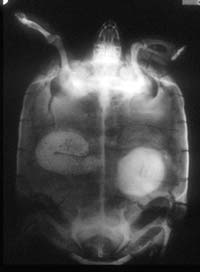Bladder stones are a common problem in many species of tortoise.
Bladder stones are a common problem in many species of tortoise. I estimate that approximately 10 percent of all tortoises seen at my hospital have bladder stones. These are usually found during routine examinations, or during a physical examination on animals presented for other problems, where the owner didn’t know that their tortoise had a stone.
There are no typical signs associated with bladder stones. A tortoise with a bladder stone can act totally normal or it may be near death. Rear leg paralysis or weakness, constipation, runny noses, egg-binding and lack of appetite are just a few signs.
The stones can be caused by a number of factors. The two most common are improper diet and dehydration. Tortoises are vegetarians. Like other animals, their diet should consist of protein, carbohydrates and fats. However, the dietary protein and fats should be of plant origin, not animal origin. Their systems are not equipped to handle large amounts of animal-based nutrients (such as dog food – a commonly fed diet that is very bad for tortoises and other herbivorous reptiles, such as iguanas).
 This desert tortoise has a large bladder stone in the left lobe of the bladder (visible on the right side of the photo). The stone is pinching off the intestine, causing constipation. |
You have probably noticed that when your tortoise defecates and urinates it produces a pasty white substance. This is called urates, which is the end product of protein digestion in reptiles. If that substance gets produced in excess it can crystallize within the tortoise’s urinary system and form a stone.
If a tortoise becomes dehydrated, which can happen in captivity from either not being offered water or being offered food with a low water content, these urates can also crystallize within the body and lead to bladder stone production.
A stone the size of the one that you describe in your tortoise is very large and has probably been there for a long time. I think all stones should be removed, as they will not go away and will only get bigger.
|
Tortoise Bladder Stones |
Think of it this way: If you put a bowling ball and a wine glass in a hard-sided suitcase, and then let a gorilla toss it around, what do you think would happen to the bowling ball and the wine glass? The bladder stone is like the bowling ball, and the tortoise’s inner organs (kidneys, liver, etc.) are like the wine glass.
Bladder stones, if left untreated, can kill a tortoise. When caught early, bladder stones are easily removed and the patient does extremely well. (See sidebar below for a brief summary of a research paper on tortoise bladder stones.) Good luck and have this problem taken care of soon.
Oh, one more thing. In regard to the stones seen in wild tortoises: It is true that they do get them, but they are often found in dead animals.

